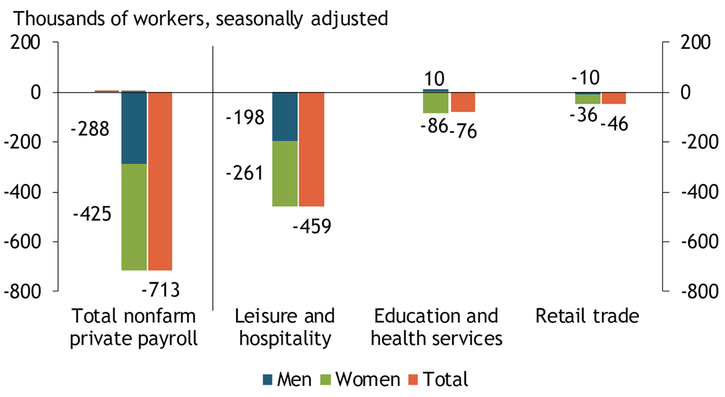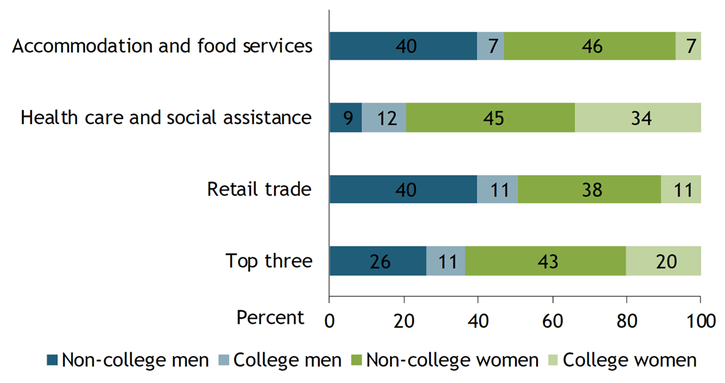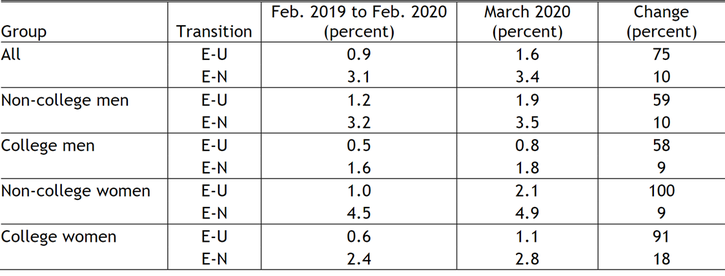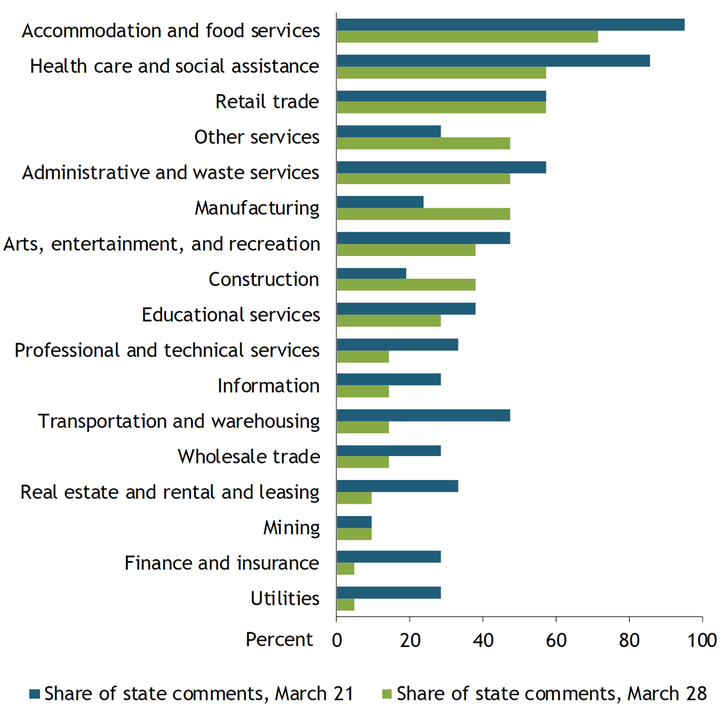The temporary shutdown orders and social distancing measures taken in March to fight COVID-19 have led to substantial job losses in the United States. According to the Bureau of Labor Statistics’ Current Employment Statistics Survey, also known as the “Establishment Survey,” nonfarm private payroll employment declined by 713,000 in March, the largest monthly decline since the Great Recession. This staggering number likely understates last month’s job losses, as the reference period of the survey does not include the second half of March when the economic shutdown intensified. Chart 1 shows that a majority (82 percent) of the decline in employment was concentrated in three broad industries: leisure and hospitality (−459,000), education and health services (−76,000), and retail trade (−46,000)._
Chart 1: Changes in Nonfarm Private Payroll Employment (March Establishment Survey)

Sources: Bureau of Labor Statistics and authors’ calculations.
Women have been disproportionately affected by job losses. Although women held less than half of all jobs in February 2020, according to the Establishment Survey, they lost 425,000 jobs in March, corresponding to 60 percent of all job losses. Women held more jobs in the hardest-hit industries—35.4 out of 56.5 million—and they have taken a bigger hit in the first wave of job losses related to the COVID-19 outbreak._
These job losses may also be unevenly distributed across workers of different education levels. However, the Establishment Survey does not provide information on workers’ education levels, nor does it allow for us to examine the sex breakdown across industry subcategories. For example, the accommodation and food services industry—the largest subset of the leisure and hospitality industry—experienced the greatest employment declines. To quantify the employment shares of workers of different sex and education groups across more narrowly defined industries, we use data from the U.S. Census Bureau’s Current Population Survey (CPS), also known as the “Household Survey.” Specifically, we group individuals into one of four categories: men with less than a bachelor’s degree (non-college men), men with a bachelor’s degree (college men), women with less than a bachelor’s degree (non-college women), and women with a bachelor’s degree (college women). Our three industries, which are subsets of the industries in Chart 1, are those that experienced substantial job losses in March: accommodation and food services, health care and social assistance, and retail trade.
Chart 2 shows that women held 63 percent of all jobs in the three hardest-hit industries, and a majority of these women did not have a college degree. In the accommodation and food services industry, women held 53 percent of all jobs, and non-college women held 46 percent of all jobs. These differences were even starker in the health-care and social assistance industries, which corresponded to 85 percent of all jobs in the broader education and health services industries. Women held almost 80 percent of jobs in the health-care and social assistance industries: 45 percent were held by non-college women, and 34 percent were held by college women. Although men held a slightly higher share of jobs in the retail trade industry—51 percent versus 49 percent for women—their overall employment share in the top three hardest-hit industries remained well below women._
Chart 2: Employment Shares by Sex and Education in the Affected Industries (February CPS)

Sources: U.S. Census Bureau and authors’ calculations.
When people lose their jobs, they transition from “employment” to one of two official statuses: “unemployment” (meaning they do not have a job but are actively looking for one) or “inactivity” (meaning they do not have a job and have not actively looked for one in the last four weeks). We use monthly data from the CPS to calculate the transition rates from employment to unemployment (defined as the number of individuals flowing from employment in month 1 to unemployment in month 2 divided by total employment in month 1) and from employment to inactivity (defined similarly) by sex and education groups.
Table 1 shows the transition rates from employment to unemployment (E-U) and from employment to inactivity (E-N) for February 2019–20 (monthly average) and March 2020, as well as the percentage change in the rates from February to March. Although more individuals flowed from employment to inactivity than to unemployment in March, the “change” column shows that the increases in E-U transitions from February to March were greater than the increases in E-N transitions. Additionally, both non-college and college women saw larger increases in E-U transitions than men. The E-U transition rate for non-college women doubled in March relative to its February 2019–20 average, while the E-U transition rate for college women increased by 91 percent. In contrast, the E-U transition rates for non-college men and college men rose by only around 60 percent. Increases in the E-N transition rates were smaller and similar across three of the four groups. Only college-educated women saw a markedly higher increase in their E-N transition rate (18 percent).
Table 1: Transition Rates from Employment to Unemployment and from Employment to Inactivity by Sex and Education Groups

Sources: U.S. Census Bureau and authors’ calculations.
Although the previous analysis offers insight into the first wave of job losses due to COVID-19, it does not cover information for the last two weeks of March. Labor market conditions deteriorated further during the second half of March as more states began to implement temporary shutdown orders and social distancing measures in response to the pandemic. Initial claims for unemployment insurance benefits reached record-high levels of 3.3 million and 6.9 million for the weeks ending March 21 and March 28, respectively.
To determine whether the same industries drove the sharp increases in initial jobless claims in the second half of March, we aggregate comments on industry-level job losses provided by states’ unemployment insurance program offices in the unemployment insurance weekly claims reports._ Chart 3 shows that a majority of states reported job losses in accommodation and food services (95 percent of states in the week ending March 21 and 71 percent of states in the week ending March 28), health care and social assistance (86 percent of states in the week ending March 21 and 57 percent of states in the week ending March 28), and retail trade (57 percent of states in the week ending March 21 and 57 percent of states in the week ending March 28)—the same three industries that had the largest job losses in the first half of March. As a result, women—especially those without a college degree—likely continued to experience larger employment losses than men in the second half of the month.
Chart 3: State-Supplied Comments on Job Losses by Industries

Sources: Department of Labor and authors’ calculations.
This imbalance in job losses could lead to prolonged damage to women’s employment and labor market attachment. In recent years, prime-age (25 to 54) women, especially those with a bachelor’s degree, had been driving the recovery in employment and labor force participation from the Great Recession (Tüzemen and Tran 2019a, 2019b). Even so, as of 2019, the labor force participation rate for women without a bachelor’s degree remained 2 percentage points below its pre-recession level. As women—and non-college women in particular—have taken a bigger hit in the first wave of pandemic-related job losses, they may experience a sharper decline and a slower recovery in employment and labor force participation if job losses deepen and persist in the coming months.
Endnotes
-
1
The temporary-help services industry, which accounts for only 13 percent of employment in professional and business services industries, also experienced a sharp decline in employment. Given the high cyclicality of this industry, we do not include it in the group of hardest-hit industries.
-
2
According to the Establishment Survey, women held around 63 percent of all jobs in these three industries in February 2020. In March, these industries lost 581,000 jobs, and women lost 383,000 jobs, corresponding to 66 percent of all jobs lost in these three industries.
-
3
CPS microdata for March indicate that nearly two-thirds of all jobs lost in nonfarm private employment were held by women, a majority (87 percent) of whom did not have a college degree. In the three hardest-hit industries, non-college women accounted for 53 percent of all job losses, college women for 28 percent, non-college men for 12 percent, and college men for 7 percent.
-
4
Comments are from states that had an increase of more than 1,000 claims and that indicated the specific industries in which claimants were formerly employed.
References
Tüzemen, Didem, and Thao Tran. 2019a. “The Uneven Recovery in the Prime-Age Labor Force Participation.” Federal Reserve Bank of Kansas City, Economic Review, vol. 104, no. 3, pp. 21–41.
———. 2019b. “Women Are Driving the Recent Recovery in Prime-Age Labor Force Participation.” Federal Reserve Bank of Kansas City, Economic Bulletin, December 18.
Didem Tüzemen is a senior economist at the Federal Reserve Bank of Kansas City. Thao Tran is a research associate at the bank. The views expressed are those of the authors and do not necessarily reflect the positions of the Federal Reserve Bank of Kansas City or the Federal Reserve System.
